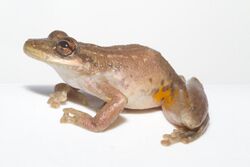Biology:Scinaxinae
| Scinaxinae | |
|---|---|

| |
| Scinax ruber | |
| Scientific classification | |
| Domain: | Eukaryota |
| Kingdom: | Animalia |
| Phylum: | Chordata |
| Class: | Amphibia |
| Order: | Anura |
| Family: | Hylidae |
| Subfamily: | Scinaxinae Duellman, Marion & Hedges, 2016 |
| Type genus | |
| Scinax Wagler, 1830
| |
| Genera | |
|
4 genera (see text) | |
Scinaxinae is a subfamily of neotropical tree frogs in the family Hylidae.[1][2] They are distributed from central Mexico down to northern Argentina , including Trinidad and Tobago.[3] These frogs are characterized by having pointy snouts.
These frogs are small to medium-sized and often stowaway on products such as house plants and fruit. Because of this, two species of Scinax have been introduced outside of their native range, with Scinax quinquefasciatus on the Galapagos Islands[4] and Scinax ruber on St. Lucia, Martinique, and Puerto Rico.[5]
Genera
There are four genera in Scinaxinae, comprising around 126 to 138 species.[2][3] As many of these frogs actually represent cryptic species complexes, the total number of species is likely much higher.
- Wagler, 1830 Duellman, Marion & Hedges, 2016
- Tschudi, 1838 Ololygon
- Julianus Fitzinger, 1843
- Scinax Sphaenorhynchus
While the first three genera have been found to be closely related, Sphaeorhynchus is not as closely related and its inclusion in Scinaxinae could be debated.[3]
This subfamily of frogs evolved approximately 42.0–56.4 Mya during the Oligocene. The most primitive of the Scinaxine frogs is Sphaeorhynchus, which remained in the Atlantic Coastal Forest of Brazil while the other lineages evolved into Julianus in the southeast, Ololygon also in the Atlantic Coastal Forest, and Scinax in the Amazon Basin.[3]
References
- ↑ "Scinaxinae Duellman, Marion, and Hedges, 2016". https://amphibiansoftheworld.amnh.org/Amphibia/Anura/Hylidae/Scinaxinae.
- ↑ 2.0 2.1 "Scinaxinae Duellman, Marion and Hedges, 2016". https://www.itis.gov/servlet/SingleRpt/SingleRpt?search_topic=TSN&search_value=1094197.
- ↑ 3.0 3.1 3.2 3.3 Duellman (19 April 2016). "Phylogenetics, classification, and biogeography of the treefrogs (Amphibia: Anura: Arboranae)". Zootaxa 4104 (1): 1–109. doi:10.11646/zootaxa.4104.1.1. PMID 27394762. http://www.cnah.org/pdf/88524.pdf.
- ↑ "Scinax quinquefasciatus Fowler, 1913". https://www.darwinfoundation.org/en/datazone/checklist?species=5022.
- ↑ "Scinax ruber (Laurenti, 1768)". 18 April 2019. https://nas.er.usgs.gov/queries/factsheet.aspx?SpeciesID=978.
Wikidata ☰ Q25388523 entry

